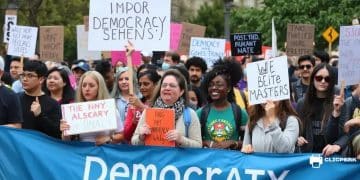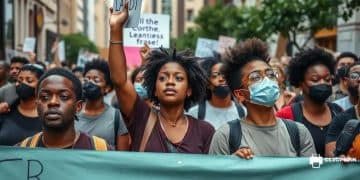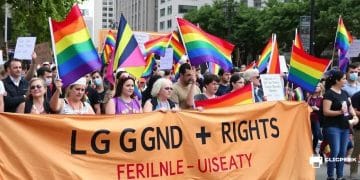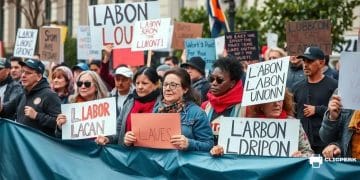Women’s rights marches: why they matter today
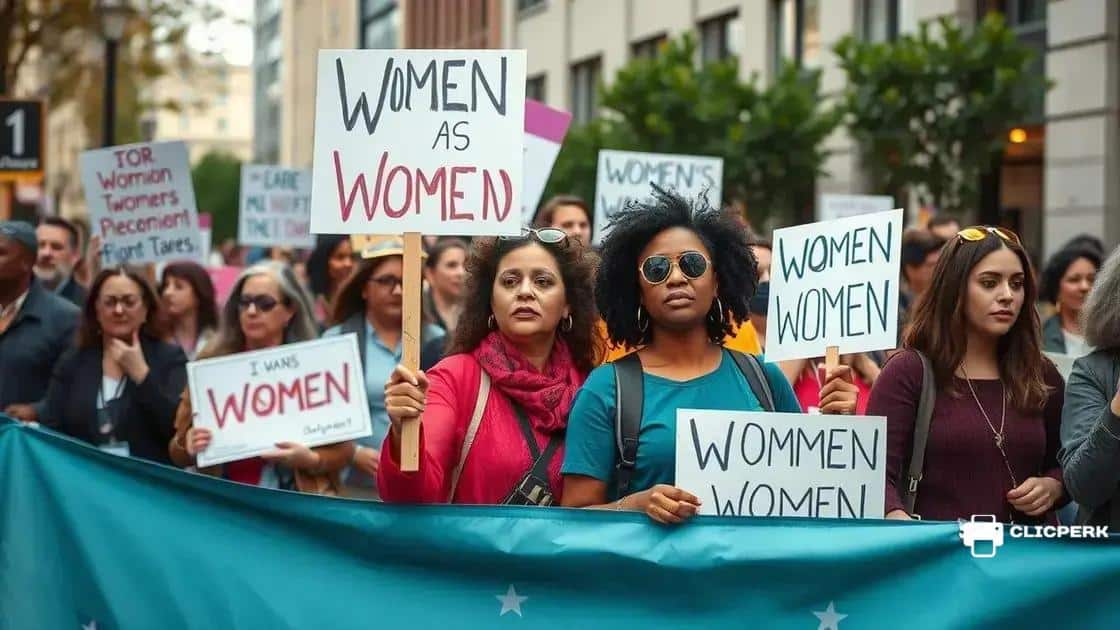
Women\’s rights marches advocate for gender equality, address issues like reproductive rights and equal pay, and unite communities globally to promote social change and raise awareness about ongoing challenges faced by women.
Women’s rights marches have been pivotal in advancing gender equality throughout history. Have you ever wondered how these powerful movements continue to influence our society today? Let’s delve into their significance.
The history of women’s rights marches
The history of women’s rights marches is rich and varied, showcasing the relentless fight for gender equality across the globe. These marches have served as powerful platforms for advocates to demand change and raise awareness about critical issues.
The Early Beginnings
In the early 20th century, women began organizing to voice their demands for suffrage and equal rights. The first significant march took place in 1913, when over 5,000 women paraded down Pennsylvania Avenue in Washington, D.C. This was a pivotal moment that echoed the sentiment of many who sought equal voting rights.
A Perspective on Major Milestones
Throughout the decades, several key events marked the rise of women’s marches:
- The 1963 March on Washington, where Martin Luther King Jr. delivered his famous “I Have a Dream” speech, also included prominent women advocating for equality.
- The Women’s Strike for Equality in 1970, which commemorated the 50th anniversary of women’s suffrage.
- The 2017 Women’s March, which became one of the largest demonstrations in U.S. history, uniting millions across the globe to advocate for women’s rights.
These events have shaped the landscape of women’s rights movements, energizing supporters and drawing attention to injustices faced by women.
Modern-Day Relevance
Today, marches continue to highlight ongoing issues such as reproductive rights, equal pay, and protection against violence. They not only serve as a reminder of past struggles but also advocate for the rights women seek in contemporary society.
The legacy of women’s rights marches is ever-evolving. While strides have been made, the fight for complete equality remains active, motivating future generations to stand up for their rights.
Key figures in the women’s rights movement
Throughout history, many inspiring individuals have played crucial roles in the women’s rights movement. These key figures have fought tirelessly for gender equality and justice, leaving a lasting impact on society.
Early Trailblazers
One notable figure is Susan B. Anthony, who was pivotal in the suffrage movement. She dedicated her life to campaigning for women’s right to vote and co-founded the National Woman Suffrage Association. Another early advocate was Elizabeth Cady Stanton, who organized the Seneca Falls Convention in 1848, marking the birth of the women’s rights movement in the United States.
Modern Influencers
Moving to more contemporary figures, Gloria Steinem stands out as a prominent leader in the feminist movement of the 1960s and 1970s. She co-founded Ms. magazine and became a voice for women’s equality. Additionally, Malala Yousafzai has emerged as a strong advocate for girls’ education globally, demonstrating how young voices can make a significant difference.
The Ongoing Fight
Other influential figures include bell hooks, a cultural critic whose writings challenge gender norms and advocate for inclusive feminism. Similarly, Ruth Bader Ginsburg, as a Supreme Court Justice, fought for gender equality through legal reforms. These leaders have not only inspired many but also shaped the discourse surrounding women’s rights.
The impact of these key figures in the women’s rights movement serves as a reminder of the ongoing struggle for equality. Each has contributed to the progress achieved today while encouraging new generations to continue the fight.
Major marches that shaped history
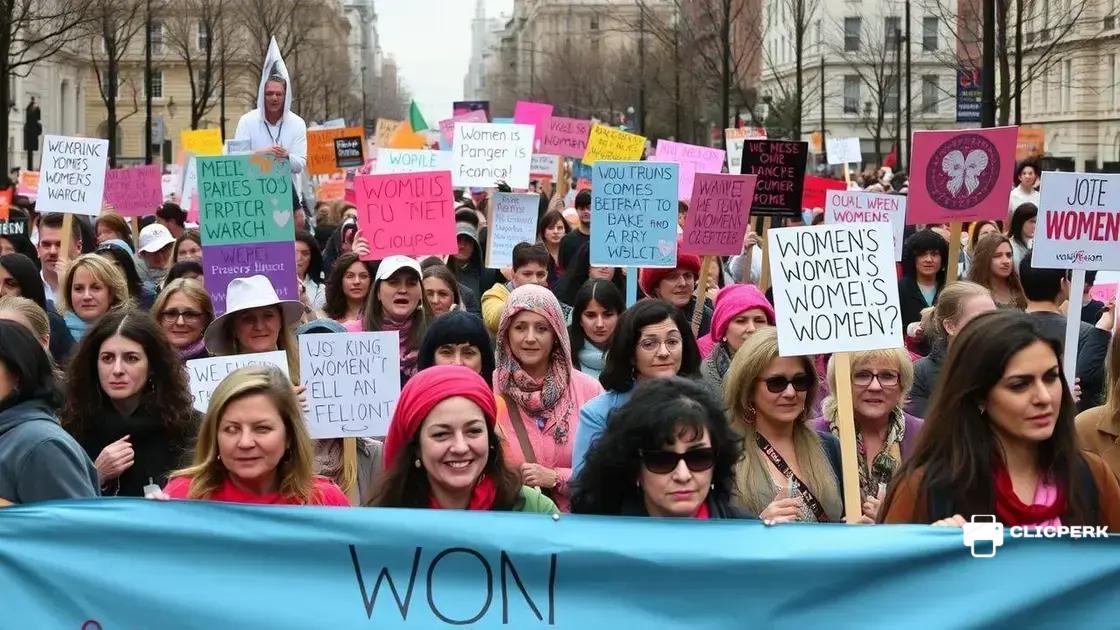
Numerous major marches have significantly impacted the course of history, shaping the landscape of women’s rights and promoting equality worldwide. These events have inspired change and galvanized movements.
The Women’s March on Washington (2017)
One of the most notable recent events is the Women’s March on Washington, which took place on January 21, 2017. Millions rallied not only in Washington, D.C., but also in cities across the globe. Participants advocated for a range of issues, including reproductive rights, equal pay, and protection against discrimination.
International Women’s Day Marches
Every year, International Women’s Day on March 8th brings people together to march for women’s rights. This global event highlights the challenges women face and demands action towards achieving gender equality. Marches gather millions of participants, demonstrating solidarity across cultures.
The Suffrage Marches
Historically, the suffrage marches of the early 20th century were crucial in securing women’s voting rights. The National Woman’s Suffrage Association, founded by leaders like Susan B. Anthony and Elizabeth Cady Stanton, organized various campaigns that culminated in the 1920 ratification of the 19th Amendment in the United States. These early protests laid the foundation for future activism.
The March for Women’s Lives (2004)
In April 2004, over a million people gathered in Washington, D.C., for the March for Women’s Lives. This event focused on reproductive rights and healthcare access, emphasizing the link between women’s autonomy and health. It united diverse groups to draw attention to these critical issues.
These major marches illustrate the power of collective action in advocating for change. Each event has served as a catalyst for movements, addressing pressing issues and inspiring generations to continue the fight for women’s rights.
Current issues addressed by women’s rights marches
Women’s rights marches continue to address a variety of critical issues that impact women’s lives today. These events serve as platforms to advocate for change and bring awareness to ongoing injustices.
Reproductive Rights
One of the most prominent issues is reproductive rights. Many marches focus on ensuring access to safe and legal abortions, as well as comprehensive reproductive healthcare. The fight for these rights remains fierce, as many women face legislative challenges that threaten their autonomy.
Equal Pay and Employment Rights
Another key concern is the fight for equal pay. Women still earn less than men for the same work in many fields. Marches highlight the need for fair pay and equal opportunities. Activists push for strong policies that ensure equal treatment in the workplace.
- The gender pay gap: Raising awareness about its effects is crucial.
- Paid family leave: Advocating for policies that support both parents.
- Discrimination in hiring: Addressing biases that affect women’s employment.
Violence Against Women
Violence against women is also a major issue tackled during these marches. Many events have brought attention to domestic violence, sexual assault, and harassment. Advocates seek stronger laws and support systems to protect victims and create safer environments.
Representation and Leadership
Additionally, representation in politics and leadership roles is a vital topic. Women remain underrepresented in many political spaces. Marches advocate for equal representation to ensure women’s voices are heard in decision-making processes.
The ongoing fight for these current issues in women’s rights marches represents a commitment to achieving equality and justice for all. Each march is a step towards a future where women can live free from discrimination and violence.
The global perspective on women’s rights marches
The global perspective on women’s rights marches reveals a unified cry for equality across different cultures and regions. Women all over the world are standing together to advocate for their rights.
Diverse Movements
In various countries, women’s marches address local issues while connecting to a global narrative. For instance, in India, the #MeToo movement has evolved into mass protests against sexual harassment and violence, demonstrating how local struggles resonate with the global fight for women’s rights.
Solidarity Across Borders
One of the remarkable aspects of these marches is the solidarity they foster. Events like the Women’s March have inspired similar demonstrations in countries like Australia, Canada, and France. Regardless of geographic location, the core message often revolves around fighting for gender equality, reproductive rights, and an end to violence against women.
- Global Marches for Climate Justice: Highlighting the intersection of women’s rights with environmental issues.
- Local Issues: Addressing specific challenges women face in different cultural contexts.
- Partnerships: Collaborating internationally to promote women’s rights initiatives.
Impact of Social Media
Social media has played a crucial role in amplifying these movements. Hashtags like #WomensMarch and #EachForEqual have connected individuals worldwide, allowing for the sharing of experiences and strategies. This global network empowers women to learn from one another and organize effectively.
Challenges Faced
Despite progress, women’s rights marches still face challenges, such as governmental pushback and societal oppression in various regions. Activists often put themselves at risk, fighting for their rights in environments that may not support gender equality.
The global perspective on women’s rights marches highlights a significant convergence of movements united by a common aim of achieving gender equality. The ongoing dialogue and collaboration across borders is vital for sustaining momentum in this essential fight.
The journey for women’s rights is ongoing and vital. Marches around the world demonstrate the power of solidarity among women united for a common cause. By raising awareness and advocating for equality, these events remind us that every voice matters. Each step taken towards equality strengthens our collective resolve to create a better future for all women. Together, we can continue to progress towards a society where everyone enjoys equal rights and opportunities.
FAQ – Frequently Asked Questions about Women’s Rights Marches
What is the main purpose of women’s rights marches?
The main purpose of women’s rights marches is to advocate for gender equality, raise awareness about issues affecting women, and promote social change.
How do women’s rights marches impact society?
These marches create visibility for women’s issues, mobilize communities, and influence public policy by pressing for legal reforms.
What current issues are addressed in women’s rights marches?
Current issues include reproductive rights, equal pay, violence against women, and representation in leadership roles.
How can I get involved in supporting women’s rights?
You can get involved by participating in marches, supporting women’s organizations, and advocating for policies that promote gender equality.
